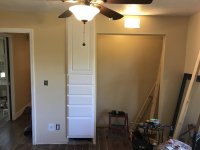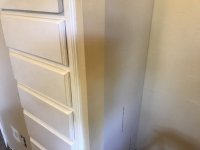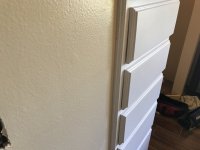Keith Thomas
Member
- Messages
- 73
- Location
- florida
This is something I just built. It needs another coat of paint which I wanted to do after instal. I basically designed it to go in the dead space on the side of a closet. Its 25" deep with full extension self close slides and the interior of the drawers are 16" wide so it provides lots of storage space. The bottom drawer is going to be used for filing ( this is basically our office) I need to do some drywall and base board then the closet doors go back on. And it still needs some knobs to dress it up a little. The case is home depot birch and the frame and fronts are home depot poplar. I was lucky enough to find some straight 1-1/2" poplar (straight enough) for the face frame so I didn't even have to rip it. Had to glue up the door panel and larger drawers.
My problem is some of the drawer fronts are hitting at the top first leaving a gap at the bottom. Similar gap on each side. the case was pretty square when I put it together. It was hard to put that 92" long case together by myself and keep it square. The drawers are square and the fronts are on flush with the drawer box.
So is there a way to fix this problem? Or is that acceptable looking? I think I rather fix it if its not to hard. I'd appreciate some input.
My problem is some of the drawer fronts are hitting at the top first leaving a gap at the bottom. Similar gap on each side. the case was pretty square when I put it together. It was hard to put that 92" long case together by myself and keep it square. The drawers are square and the fronts are on flush with the drawer box.
So is there a way to fix this problem? Or is that acceptable looking? I think I rather fix it if its not to hard. I'd appreciate some input.



